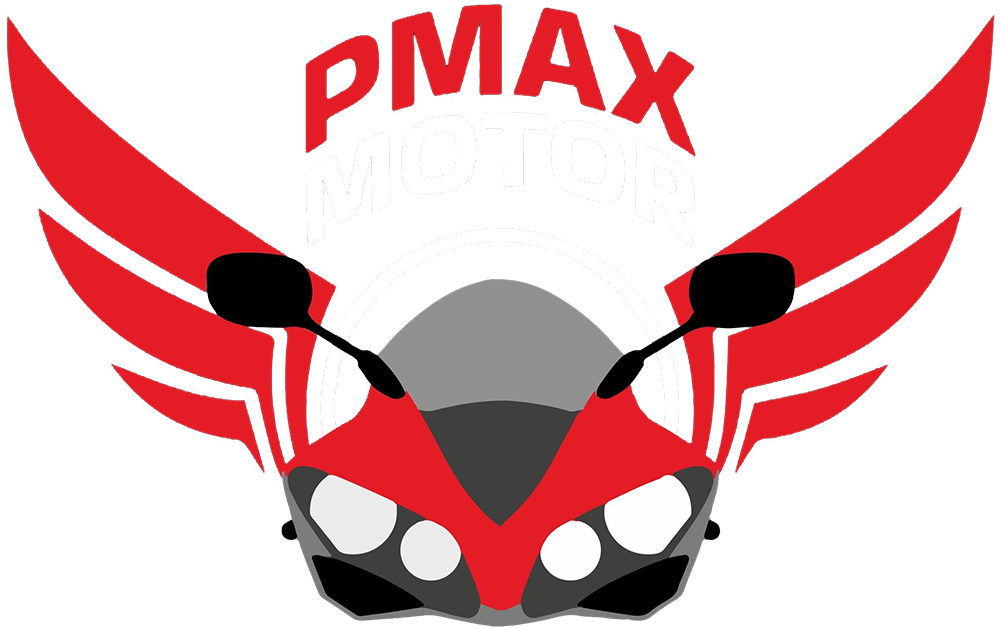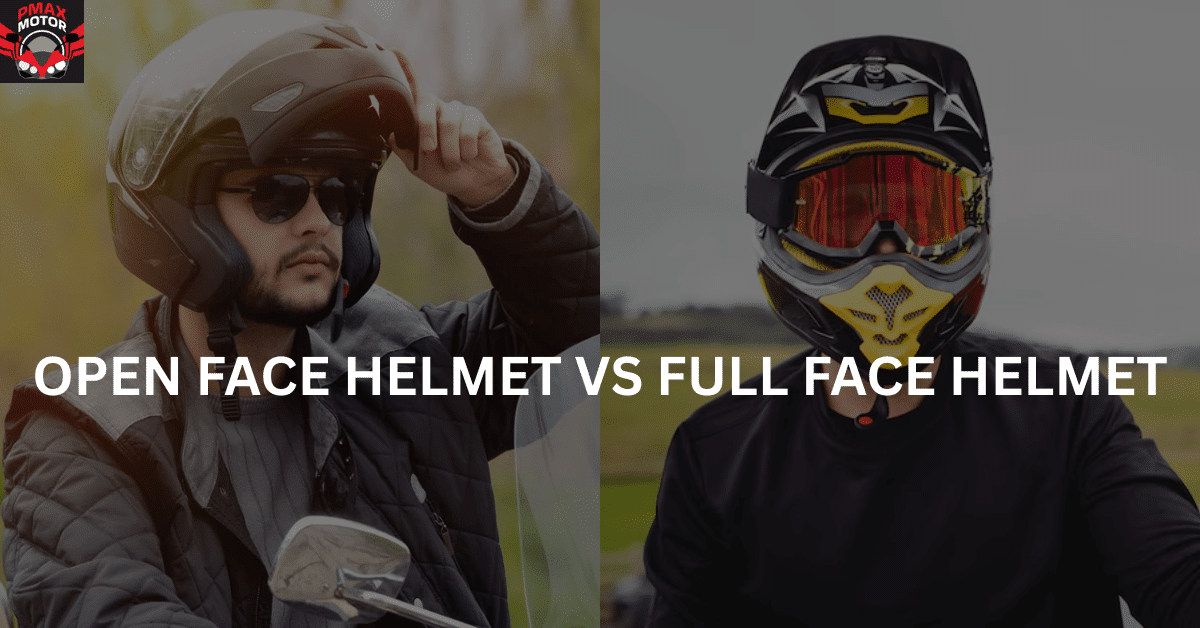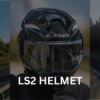No products in the cart.
Open Face Helmet vs Full Face Helmet: Which is Better?
When it comes to riding gear, your helmet is the most personal and arguably the most important choice you’ll make, other than the motorbike of course.
Whether you’re riding to work, making deliveries, or heading for a longer journey to balik kampung, the right helmet affects comfort, safety, and even confidence on the road.
Among all the styles available, two remain the most common: the full face helmet and the open face helmet. Each has its own group of loyal users, and both are widely available with SIRIM approved safety ratings in Malaysia.
So, how do you decide which one suits your riding needs better?
Table of Contents
ToggleTypes of Helmets at a Glance
Before we compare the two main styles, here’s a simple table to understand how they differ:
Feature | Full Face Helmet | Open Face Helmet |
Coverage | Entire head including chin and jaw | Covers top, sides and back, leaves face exposed |
Chin Protection | Yes | No |
Weight | Heavier | Lighter |
Airflow | Less natural airflow (ventilation-dependent) | High airflow (open front) |
Noise Isolation | Better at reducing wind and traffic noise | Louder, more exposed |
Eye Protection | Built-in visor, sometimes Pinlock-ready | May or may not include a visor |
Versatility | Suitable for all speeds, weather and road types | Ideal for slower rides and hot weather |
1. Safety Comes First
A full face helmet naturally offers better protection because it covers more of the head, including the jaw. This becomes important during high-impact crashes, especially those involving the chin area.
“According to impact data from road safety studies, the chin is among the most commonly hit areas during motorcycle accidents.”
An open face helmet still protects the skull well, provided it meets a proper standard like SIRIM or ECE 22.06. But it leaves the lower face exposed, which could lead to facial injuries in a direct collision.
SIRIM-certified helmets in both categories pass strict impact and retention tests in Malaysia. When comparing models, check for this label first to ensure its passed proper regulation.
2. Ventilation and Heat Management
Malaysia’s climate doesn’t leave much room for error in comfort. The weather can get erratic, one moment is sunny and the next it’s basically a typhoon. If your head gets too hot, you will lose focus and even become dizzy and disorientated, two no-nos while driving on the road.
This is where open face helmets shine, quite literally. The unrestricted airflow makes riding through traffic or on short urban rides feel less stuffy.
However, many full face helmets today come with advanced airflow systems, with top, chin, and exhaust vents that keep air moving even in slower conditions. Does it come with an extra price? You bet it does, but it’s something to consider when choosing between the two.
Things to consider:
- Open Face Helmet: Best airflow, especially when stopping frequently (delivery riding).
- Full Face Helmet: Better for longer rides and highways, retains internal temperature better.
3. Noise and Wind Resistance
Wind noise can wear you out faster than you think, especially after long rides. A full face helmet seals around the head more completely, so wind and engine noise are less intense and when you consider the traffic jams, excessive honkings and noise pollutants Malaysia has to offer, a full face helmet does sound nice.
In contrast, open face helmets are noisier, even at slower speeds. The open design lets more sound through, and there’s more pressure on the ears when the wind picks up.
If you frequently ride on highways, windswept coasts or longer routes, noise comfort should be on your checklist. Do not ignore this
4. Visibility and Convenience
You get unobstructed vision with an open face helmet, something many delivery riders and city commuters appreciate. It’s easier to check side mirrors or look over your shoulder, especially when traffic is busy and you need to weave between the cars.
That said, modern full face helmets come with wider visors, plus some include internal sun visors, which eliminate the need for sunglasses or tinted shields, but visibility is a huge consideration for many.
In terms of putting the helmet on and off, open face helmets are quicker and easier. That matters if you’re making frequent stops, a big plus for Grab riders or any delivery couriers.
5. Protection vs Comfort Trade-Off
Here’s a simple comparison to weigh the real-world pros and cons.
Helmet Type | Pros | Cons |
Full Face Helmet | – Maximum protection, including chin and jaw – Quieter ride with better wind insulation – Safer for higher-speed riding – Visors often support Pinlock inserts to prevent fogging | – Can feel hot in traffic if airflow is limited – Heavier; may feel snug in humid weather – Slower to remove during short breaks |
Open Face Helmet | – Lightweight and naturally breathable – Excellent field of vision – Quick to wear or remove, ideal for frequent stops – More comfortable during short, city-based rides in hot weather | – No protection for the chin or face area – Louder due to exposure to wind and traffic noise – Not ideal for high-speed or long-distance travel |
6. Price and Longevity
Price differences between full face and open face helmets often come down to features, materials, and brand reputation, but you don’t always have to break the bank to get something safe and practical.
In Malaysia, well-known premium brands like Arai, Shoei, and HJC offer high-end protection with advanced materials, multi-layered shells, and luxury-level liners. However, there are also more affordable but reliable options that are widely used among everyday riders:
- KYT: Popular among delivery and daily riders for being lightweight, aerodynamic, and still SIRIM-certified.
- LS2: Offers a wide range of styles, known for value-for-money and decent ventilation.
- Givi: Frequently seen in city traffic, especially for open face designs. Known for comfort and price.
- Bilmola: A Thai brand growing in popularity, offering flashy designs and budget-friendly options.
- NHK, ZEUS, and SHARK are also fairly common in the local scene.
Here’s a basic breakdown:
Helmet Type | Price Range (Approx.) | Durability | Notes |
Full Face | RM250 – RM3,500+ | 3–5 years+ | Higher cost, better all-around protection. Ideal for long distances or higher speeds. |
Open Face | RM100 – RM1,500 | 2–4 years | More affordable, great for city use. May require a visor upgrade or goggles. |
When comparing helmets, it’s not just about the price tag. Fit, certification, and comfort should all come first. A good-fitting helmet that meets SIRIM or ECE 22.06 standards will serve you far better in the long run than a cheaper one that compromises safety.
And don’t forget, a helmet’s shell and internal foam do degrade with time, especially under heat and sweat, so replacing it every few years is part of the cost of riding.
Certification: Don’t Skip It
In Malaysia, helmets must meet specific safety standards and for good reason. A certified helmet means it has passed actual impact tests, not just been built to look tough. The most basic certification to look for locally is SIRIM, which ensures the helmet meets government-approved safety requirements.
“Always choose a helmet that is certified by SIRIM for local compliance.”
Also look out for ECE 22.06 or Snell certification if the helmet is imported. These are internationally recognised (America and Europe) and indicate tested performance under various impact conditions.
Some budget helmets skip proper testing, but a helmet without certification is just a hat. Safety isn’t a place to compromise, don’t forget this alright?
Which Helmet Suits Which Type of Rider?
To make your decisions and choices ever easier to narrow down, consider what type of rider you are.
Rider Type | Best Helmet Choice |
City commuter with frequent stops | Open face helmet |
Delivery rider in busy traffic | Open face helmet (certified) |
Weekend sport rider | Full face helmet |
Highway commuter | Full face helmet |
Mixed-use (city and long rides) | Full face or modular helmet |
Modular helmets, which combine both designs (a flip-up chin bar), are a decent middle ground, but that’s a separate topic altogether and we won’t get into it. Leave a comment down below if you are interested in the topic and we will look into it!
Choose Comfort Without Forgetting Protection
At the end of the day, what you wear on your head should do more than just complete your look, it should protect you when it matters most. If your daily ride involves weaving through traffic, frequent stops, and scorching heat, a certified open face helmet can offer the airflow and comfort you need without sacrificing too much on safety.
At Pmax Motor, we understand the riding conditions in Malaysia, the heat, the humidity, the endless stop-and-go traffic, and yes, even the noise. That’s why we offer a curated selection of full face helmets, open face options, and other motorcycle accessories suited for local riders who want proper protection without giving up comfort.
Whether you’re navigating the city or riding further out into the countryside, the best helmet is the one that fits well, carries trusted certifications like SIRIM or ECE, and keeps up with your routine.
We’re here to help you ride safer, cooler, and smarter.
Frequently Asked Questions About Open Face Helmet vs Full Face Helmet
Can I Use an Open Face Helmet on the Highway?
You can, but it’s not ideal. Open face helmets offer less protection and more wind noise, which can be tiring on long or high-speed rides.
Do Open Face Helmets Provide Enough Protection in a Crash?
They protect the skull well, but leave the chin and jaw exposed. In face-first impacts, they offer much less safety than full face helmets.
Are Full Face Helmets Too Hot for Malaysia’s Weather?
They can get warm in traffic, but many now come with advanced ventilation systems that keep airflow manageable even in humid conditions.
How Often Should I Replace My Helmet?
Most manufacturers recommend replacing your helmet every 5 years, or immediately after a significant impact, regardless of type.
Do All Helmets Need to Be SIRIM Certified in Malaysia?
Yes, for legal road use. Imported helmets with ECE or Snell certification are accepted too, but should still carry SIRIM labels when sold locally.
Can I Wear a Face Mask or Balaclava Under My Helmet?
You can, and many riders do, especially to reduce sweat or for hygiene. Just make sure it doesn’t affect the fit or comfort of the helmet.
Tags: Motorcycle helmet



